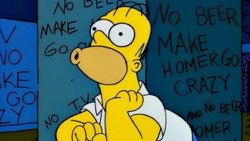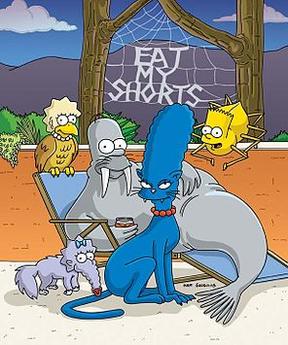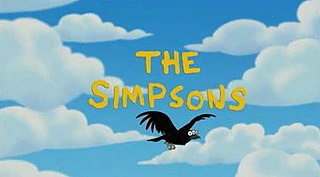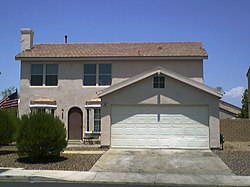
Reverend Timothy "Tim" Lovejoy, Jr. is a recurring character in the animated television series The Simpsons. He is voiced by Harry Shearer, and first appeared in the episode "The Telltale Head".

"Treehouse of Horror" is the third episode of the second season of the American animated television series The Simpsons. It originally aired on the Fox network in the United States on October 25, 1990. The episode was inspired by 1950s horror comics, and begins with a disclaimer that it may be too scary for children. It is the first Treehouse of Horror episode. These episodes do not obey the show's rule of realism and are not treated as canon. The opening disclaimer and a panning shot through a cemetery with humorous tombstones were features that were used sporadically in the Treehouse of Horror series and eventually dropped. This is also the first episode to have the music composed by Alf Clausen.
"All's Fair in Oven War" is the second episode of the sixteenth season of the American animated television series The Simpsons. It originally aired on the Fox network in the United States on November 14, 2004. In the episode, Marge gets her kitchen remodeled and the dishes she makes inside it get rave reviews. The suggestion of Ned Flanders leads her to enter a cooking contest. However, Marge realizes the competition is harder than it seems. Meanwhile, Bart finds Homer's vintage Playdude magazines and decides to adopt the lifestyle he sees within the articles.

"Treehouse of Horror IV" is the fifth episode of the fifth season of the American animated television series The Simpsons and the fourth episode in the Treehouse of Horror series of Halloween specials. It originally aired on the Fox network in the United States on October 28, 1993, and features three short stories called "The Devil and Homer Simpson", "Terror at 5+1⁄2 Feet", and "Bart Simpson's Dracula".

"Lisa's First Word" is the tenth episode of the fourth season of the American animated television series The Simpsons. It was first broadcast on the Fox network in the United States on December 3, 1992. In the episode, as the Simpson family gathers around Maggie and tries to encourage her to say her first word, Marge reminisces and tells the story of Lisa's first word. Maggie's first word is voiced by Elizabeth Taylor.
"Treehouse of Horror III" is the fifth episode of the fourth season of the American animated television series The Simpsons. It originally aired on the Fox network in the United States on October 29, 1992. The third annual Treehouse of Horror episode, it features segments in which Homer buys Bart an evil talking doll, Homer is a giant ape which is captured by Mr. Burns in a parody of the 1933 version of King Kong, and Bart and Lisa inadvertently cause zombies to attack Springfield.

"Treehouse of Horror V" is the sixth episode of the sixth season of the American animated television series The Simpsons, and the fifth entry in the Treehouse of Horror series. It originally aired on the Fox network in the United States on October 30, 1994, and features three short stories: "The Shinning", "Time and Punishment", and "Nightmare Cafeteria".

"Treehouse of Horror VIII" is the fourth episode of the ninth season of the American animated television series The Simpsons. It first aired on the Fox network in the United States on October 26, 1997. In the eighth annual Treehouse of Horror episode, Homer Simpson is the last Springfieldian left alive when a neutron bomb destroys Springfield until a gang of mutants come after him, Homer buys a transporter that Bart uses to switch bodies with a housefly, and Marge is accused of witchcraft in a Puritan rendition of Springfield in 1649. It was written by Mike Scully, David X. Cohen and Ned Goldreyer, and was directed by Mark Kirkland.

"Treehouse of Horror IX" is the fourth episode of the tenth season of the American animated television series The Simpsons. It first aired on the Fox network in the United States on October 25, 1998. This is the ninth Treehouse of Horror episode, and, like the other "Treehouse of Horror" episodes, contains three self-contained segments: In "Hell Toupée", Homer gets a hair transplant and is possessed by the spirit of an executed criminal; in "Terror of Tiny Toon", Bart and Lisa are trapped in a special, extremely violent episode of The Itchy & Scratchy Show; and in "Starship Poopers", Marge reveals that Maggie is the product of a one-night stand with the alien Kang.

The Simpson family are the main fictional characters featured in the animated television series The Simpsons. The Simpsons are a nuclear family consisting of married couple Homer and Marge who were high school sweethearts and their three children, Bart, Lisa, and Maggie. They live at 742 Evergreen Terrace in the fictional town of Springfield, United States, and they were created by cartoonist Matt Groening, who conceived the characters after his own family members, substituting "Bart" for his own name. The family debuted on Fox on April 19, 1987, in The Tracey Ullman Show short "Good Night" and were later spun off into their own series, which debuted on Fox in the U.S. on December 17, 1989, and started airing in Winter 1989.

"Treehouse of Horror 13" is the first episode of the fourteenth season of the American animated television series The Simpsons, and the thirteenth Treehouse of Horror episode. It first aired on the Fox network in the United States on November 3, 2002, three days after Halloween. It is the second Halloween episode to have a zombie related segment, and the last Halloween to have three separate writers credited for writing three stories. It is also the first Halloween episode to be titled Treehouse of Horror in the opening credits, as all prior Halloween episodes were referred to as The Simpsons Halloween Special. It is the first of these episodes not to have a Roman numeral used in its opening title.
"Bart Gets an Elephant" is the seventeenth episode of the fifth season of the American animated television series The Simpsons. It originally aired on the Fox network in the United States on March 31, 1994. In this episode, Bart wins a radio contest and is awarded a full-grown African elephant that he names Stampy. After Stampy wrecks the Simpsons' house and eats all the food, Homer decides to sell Stampy to an ivory dealer. Bart runs away with Stampy to save his pet, but the family finds the two at a museum exhibit, where Homer sinks into a tar pit. Homer is saved by Stampy, and so gives the elephant away to an animal refuge instead.

"Hurricane Neddy" is the eighth episode of the eighth season of the American animated television series The Simpsons. It originally aired on the Fox network in the United States on December 29, 1996. It was written by Steve Young, directed by Bob Anderson, and features a cameo by Jon Lovitz as Jay Sherman from The Critic. In the episode, a violent hurricane strikes Springfield. By pure chance, the only house destroyed belongs to Ned Flanders. As a result, Ned begins to lose his faith in God and the townspeople around him, especially Homer, leading him to a nervous breakdown.
"Miracle on Evergreen Terrace" is the tenth episode of the ninth season of the American animated television series The Simpsons. It originally aired on the Fox network in the United States on December 21, 1997. Bart accidentally ruins Christmas for the Simpson family by burning down the tree and all their presents.
"Home Sweet Homediddly-Dum-Doodily" is the third episode of the seventh season of the American animated television series The Simpsons. It originally aired on the Fox network in the United States on October 1, 1995. In the episode, the Simpson children are put in foster care at Ned and Maude Flanders' house. Homer and Marge are forced to attend a parenting class to get their children back.

The Simpsonsopening sequence is the title sequence of the American animated television series The Simpsons. It is accompanied by "The Simpsons Theme". The first episode to use this introduction was the series' second episode "Bart the Genius".

"Treehouse of Horror XVIII" is the fifth episode of the nineteenth season of the American animated television series The Simpsons. It first aired on the Fox network in the United States on November 4, 2007. In the eighteenth annual Treehouse of Horror episode, Bart harbors Kodos the alien in "E.T., Go Home," Homer and Marge are husband and wife assassins who try to take each other out in "Mr. & Mrs. Simpson," and Ned Flanders is given God-like powers during his demonstration on the wages of sin in "Heck House." It was written by Marc Wilmore and directed by Chuck Sheetz. Maggie Simpson does not appear in this episode.
"The Kids Are All Fight" is the nineteenth episode of the twenty-sixth season of the American animated television series The Simpsons, and the 571st overall episode of the series. The episode was directed by Bob Anderson and written by Rob LaZebnik. It originally aired on the Fox network in the United States on April 26, 2015.
"Manger Things" is the 16th episode of the thirty-second season of the American animated television series The Simpsons, and the 700th episode overall. It aired in the United States on Fox on March 21, 2021. The episode was directed by Steven Dean Moore and written by Rob LaZebnik.













